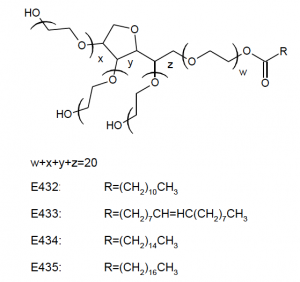What is Polysorbate 60 (E435) in Food and vs Polysorbate 65, 80?

Production | Uses | Safety | Side effects | FAQs
Polysorbate 60 or Tween 60, the full name polyoxyethylene (20) sorbitan monostearate, is an ingredient made from sorbitol, stearic acid (C18) and ethylene oxide. It is primarily used as an emulsifier in food (the European food additive number E435) and a solubilizer & surfactant in cosmetics.
Like other polysorbates, the number 60 after polysorbate means the type of fatty acid, here is monostearate; the number 20 following polyoxyethylene indicates the total number of oxyethylene groups in the molecule structure.
How is it made?
According to the FDA, polysorbate 60 is manufactured by reacting stearic acid with sorbitol to obtain sorbitan monostearate first and then condensed with ethylene oxide. (1)
What is it made of?
As the commercial food grade stearic acid usually contains palmitic acid, so polysorbate 60 is a mixture of ethoxylated ethers of stearic and palmitic acid esters of sorbitol and its mono- and dianhydrides and other related compounds.
Specification
| Other Names | Tween 60 |
| CAS Number | 9005-67-8 |
| Chemical formula | C64H126O26 |
| Molecular Weight | 1312 |
Properties
Appearance
A lemon to orange-coloured oily liquid or semi-gel at 25°C. (2)
Structure

Image Source
- Hydrophilic groups: long polyoxyethylene groups
- Lipophilic group: stearic acid
Hydrophile-Lipophile Balance (HLB)
14.9, gives oil-in-water emulsions, O/W.
It is more lipophilic than polysorbate 20 and 40 due to the long length of the fatty acids – stearic acid, compared with other fatty acids, lauric acid (C14) and palmitic acid (C16) that linked to the polyoxyethylene sorbitan part of the molecule, respectively.
Solubility
- Soluble in water, insoluble in mineral oil and vegetable oils.
- Soluble in ethyl acetate and toluene.
What’re the Uses of Polysorbate 60?
Polysorbate 60 is a synthetic multi-ingredient that can be used as a surfactant, emulsifier, solubilizer, stabilizer in food, cosmetics and personal care products.
Food
Polysorbate 60 helps water-based and oil-based ingredients blend easily and prevent their separation in food. Polysorbate 60 and 80 are mostly used in food among the category of polysorbates, but the latter is used more than 60 in food.
As a high HLB emulsifier, its food grade can be blended with a low HLB emulsifier (e.g. sorbitan stearate, mono and diglycerides) to provide a suitable HLB value for the various food uses, either oil in water, or water in oil emulsion.
Cosmetics
Its general purpose in cosmetics is to mix water and oil together. Polysorbate 60 functions as a surfactant, emulsifier, solubilizer and dispersing agent.
Some of its applications as follows:
- Help wash away body dirties by lowering the surface tension on the skin when used in shampoos and body washes.
- Distribute essential oils, fragrances and colorants evenly in water.
Following cosmetic products may with it:
- Lotions
- Creams
- Hair products
- Skin care products
- Makeup products
Is Polysorbate 60 Safe to Eat?
Yes, it has been approved as a safe ingredient by the U.S. Food and Drug Administration (FDA) and European Food Safety Authority (EFSA), as well as the Joint FAO/WHO Expert Committee on Food Additives (JECFA).
FDA
Polysorbate 60 may be safely used in food with multifunctions, such as an emulsifier, foaming agent, dough conditioner, dispersing agent, and surfactant & wetting agent.
The following food may contain it and the maximum usage (3):
- Whipped edible oil topping 0.4%
- Shortenings and edible oils 1%
- Ice cream 0.1%
- Dressings 0.3%
- Cakes and cake mixes, icings and fillings 0.46%
- Sugar confection coatings 0.2%
- Vegetable fat-water emulsions 0.4%
- Yeast-leavened bakery products 0.5%
EFSA
Polyoxyethylene (20) sorbitan monostearate (E435) is listed in Commission Regulation (EU) No 231/2012 as an authorised food additive and categorized in “Additives other than colours and sweeteners” (4).
Safety re-evaluation in 2018
Its safety was re-evaluated in 2018, together with other polysorbates (20, 40, 65, 80). (5)
UK Food Standards Agency
Categorized in “Emulsifiers, stabilisers, thickeners and gelling agents” (6)
Food Standards Australia New Zealand
It is approved ingredient in Australia and New Zealand with the code number 435. (7)
JECFA
Function Class: food additives, emulsifier. (8)
Acceptable daily intake: ADI “0-25mg/kg bw” set in 1973. (9)
What are the possible Side Effects of Polysorbate 60?
When we talk about the side effects of polysorbates, mostly focus on two carcinogens, one is ethylene oxide (Group 1), the raw material for the production; another one is 1,4-dioxane (Group 2B), a by-product of polysorbate ethoxylation.
However, the safety of these two substances in polysorbates have been approved due to the very few assay.
See also:
Details of the safety of two carcinogens
Frequently asked questions
What is the difference with polysorbate 65?
Polysorbate 65, the full name polyoxyethylene (20) sorbitan tristearate. There are three stearic acids in its molecule structure while polysorbate 60 only has one.
Is it Natural?
It is not natural as it is made from chemical synthesis between sorbitan fatty acid with ethylene oxide.
Is it Halal?
Yes, polysorbate 60 would be halal if the fatty acid stearic acid is sourced from vegetable oils.
Is it Vegan?
Yes, it is vegan if the fatty acid stearic acid derived from vegetable oils which are suitable for vegetarians. Stearic acid used to synthesize polysorbate 60 may also come from animal sources.
Conclusion
Now you may have a knowledge of the emulsifier – polysorbate 60 (E435), from the following aspects:
- Production process
- Uses
- Safety
- Side effects
- FAQs: compare with polysorbate 65 and 80
I’m probably forgetting some information about polysorbate 60, and if you have any questions or remarks about this additive, feel free to let me know in the comments.



Does T-1 60K have any helpful weight gaining value if feed to cattle as an additive to grain ?
not find some proof for that.
ethylene oxide is a carcinogen but is concidered safe in this concoction…once in the body who knows what happens to it. Many ingredients are deemed safe as we don’t have a better alternative at this time but keep in mind toxins accumulate day after day. After decades of this trickle effect comes autoimmune diseases.
Polysorbate 60 always gives me a 22 hour migraine headache. It has nearly ruined my life. Years ago, nearly half of the products at a grocery story contained that horrible chemical.
…body dirties.
That cracked me up.
Thanks man
Can food products be considered organic if they contain polysorbate 60?
Organic or not depends on the products. What are food products you find polysorbate 60?
I’ve found polysorbate 60 in coconut milk. Would it still be considered organic coconut milk if it has it? Thanks